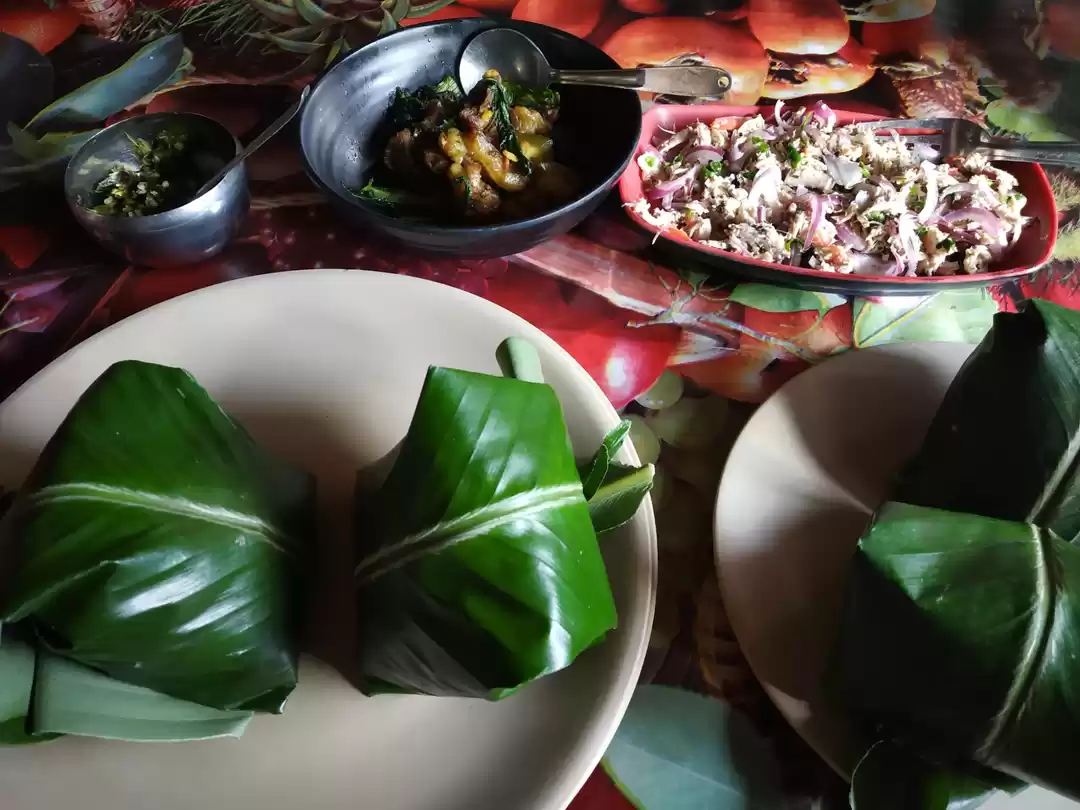
It was the month of July in the year 1990. Eight of us, students of Chemical Branch in Assam Engineering College arrived in Digboi to do Summer Internship in Digboi refinery of Indian Oil Corporation's (IOC) Assam Oil Division(AOD). The small town of Digboi in the remote north eastern corner of the country is the birth place of the Oil Industry in India. Located near Dibru Saikhowa and Dihing Patkai National Parks, Digboi offers great scenic beauty. The AOD township of Digboi was established by the British with properly planned infrastructure. With its hilly terrain, large areas covered with forest, dotted with European styled bungalows and a Golf course it is a wonderful place to be.
Our group of eight consisted of four girls: Dipanjali, Kabita, Rupa, myself and four boys: Manik, Bhaskar Lal, Nirupam and Kandarpa. We girls were given accommodation in a beautiful bungalow which was the living quarter for senior Nursing staff of AOD hospital. It was pleasant one and a half months for us in that small pretty township getting our first industrial exposure in the refinery. Refinery officers and staff were friendly and some of them invited us to their residences. My father was posted in Namdapha National Park in Arunachal Pradesh at that time and other friends had relatives living in nearby places. Manik belonged to nearby Bordumsa in Arunachal Pradesh. During weekends we visited those places. One of the not so pleasant experiences was my getting admitted in the hospital for a night due to viral fever!


Though we knew Digboi refinery to be Asia's oldest refinery, yet at that point of time we were not too conscious about Digboi's unique place in the history of Petroleum Industry. After completion of graduation, one of our friends, Bhaskar Lal, from our group of eight got recruited in Digboi Refinery. I got job with ONGC. After becoming an oil woman, I gradually started learning more about history of Petroleum industry and significance of Digboi in it.
The Earliest record to the existence of oil in India is found in the memoirs and dispatches of the Army Officers who penetrated the jungles of Upper Assam since 1825. Lt. R. Wilcox, Major A. White, Capt. Francis Jenkins, Capt. P.S. Hanney-they all saw at different times petroleum exuding from banks of the Dihing River. Mr. C.A. Bruce (1828) and Mr. H.B. Medicott (1865) of the Geological Survey of India also saw oil while prospecting for coal in Upper Assam.
Mr. Goodenough of McKillop, Stewart & Co. Calcutta was the first in India to start a systematic programme of drilling for oil. Just seven years after the world's first commercial oil well was drilled in 1859, by Col Edwin L Drake in Pennsylvania, USA-the first oil well was hand dug in November 1866, at Nahorpung about 30 miles (48 km) south east of Dibgoi in India. It was drilled up to 102 feet (31 m) and proved dry. However the second well struck oil at Makum near Margherita.
Digboi's tryst with history began in 1867 when engineers extending the Dibru-Sadiya railway line to Ledo for the Assam Railways and Trading Company (AR&TC) in 1882 noticed that the mud on one of the elephant's feet used for haulage smelled of oil. Retracing the trail of footprints, they found oil seeping to the surface. One of the engineers, Willie Leova Lake, was an 'oil enthusiast' and persuaded the company to drill a well. The first well, Discovery well 1, was started in September 1889 and the well was completed at a total depth of 662 feet (202 m) in November 1890. It is said that Digboi got its name from the instruction given by Mr Lake to his men - "DIG BOY, DIG." In 1893, AR&TC installed a tiny test refinery at Margherita, about 20 kms from Digboi, and crude oil from Digboi was sent there by rail.
Since AR&TC did not have any expertise of its own in drilling and petroleum refining, it set up a new company called Assam Oil Company (AOC) in 1889 exclusively for taking care of its oil interests. AOC started construction of a full-fledged petroleum refinery in 1900, the first in Asia and commissioned it in 1901. The products were kerosene, wax oil for lubrication, fuel oil and grease with an annual production of 500 barrels.
In 1902, AOC began selling kerosene and other petroleum products, for the first time for any refinery to undertake marketing operations in a systematic way.
In 1981, by an act of Parliament, AOC was merged with Indian Oil Corporation (IOC) and bacame the Assam Oil Division (AOD) of IOC
The nostalgia of those one and half months combined with increased awareness about Digboi's oil heritage made me eager to visit Digboi once more. Though I was posted at Nazira which is not too far off from Digboi for ten years from 1993 to 2003, somehow I could not visit Digboi. Then I went out of Assam on transfer and came back only in 2019 after long sixteen years, this time to Jorhat. Now I was determined to go to Digboi and contacted my friend Bhaskar. However Covid played spoilsport and twice I had to abandon my plans. Recently I got an official assignment to go to Duliajan to attend a Public meeting on the occasion of Diamond Jubilee celebration of M/s Assam Gas Company Limited, our customer for gas. My official engagement was on Sunday morning. So I decided to go to Digboi previous day with my spouse Sanjay and contacted Bhaskar again. Luckily he could arrange accommodation for us in Hornbill Villa, their Central Transit Accommodation despite there being a rush. On Saturday morning we set out for Digboi guided by Google via Dhodar Ali and NH 702 C. The road is good passing through tea estates which are lush green at this time. Though the road is not very wide, it does not create much inconvenience as traffic is less. Weather was pleasant and we passed through pretty small townships and villages. Around noon we passed by the famous Namphake Buddhist Monastery and saw a restaurant called Ethnic Hut. We decided to give it a try and settled for a vegetarian traditional thali meal. Simple yet amazingly delicious, consisting of some rice wrapped in banana leaf, boiled pulse with coriander leaf, steamed vegetables, local spices and chutney, it is one of the best meals I have ever had!


After passing through Dihing Patkai National Park we reached Digboi in the afternoon and headed straight to Digboi Oil Centenary Museum inaugurated in 2002 on the occasion of centenary celebration of Digboi refinery. To our dismay we found that it is still not open to general public after Covid induced lock down. Once again Bhaskar helped us by calling competent authority and arranged permission for us.
Built on the fringes of Discovery well 1, this museum is a treasure house of memorabilia with tools and equipment of yesteryear on display both inside and outside the museum building. There is an air raid shelter of world war two at the entrance of the museum and hordes of pictures and documents inside the museum depicting the history of Digboi. Standing near the Discovery well 1, I had goose bumps. Both of us being from Petroleum industry visiting the first commercial oil well of India and being in the premises of the oldest operational refinery of Asia (one of the oldest operational refinery of the world too) was like a pilgrimage for us.


Apart from owning and operating the country's oldest oilfield, the refinery and the petroleum product marketing setup, AOC had several other firsts to its credit. Digboi oilfield, now under OIL, is perhaps the only oilfield in the world which has been producing oil for more than 100 years. Asia's first oil terminal at Tinsukia was linked to Digboi refinery. Also, the first product pipeline from Digboi to Tinsukia covering a distance of 34 kms was laid in 1926. For 80 years from 1901, Digboi refinery was the country's only integrated oil refinery, undertaking all the operations - drilling and exploration, production of oil, refining and marketing - under one roof. Digboi refinery was the first refinery in the country to use natural gas as fuel. It also set the pioneering example of distributing piped gas for domestic use. The Digboi refinery was the first in the country to extract gasoline from natural gas. For more than 50 years, it was the only refinery in the country doing such an operation. Digboi refinery has the distinction of being the first refinery in the country to export products to Australia, Germany and UK. Digboi formed the nucleus of research and development in the petroleum industry.
After visiting the Museum we went round the AOD township to re-visit the areas I lived during my internship including the thriving market complex. Then we went to Hornbill Villa which is very well maintained. Food and service is also reasonably good.

Next morning we went for morning walk and I was struck by the beauty of the campus. It was such a nice combination of natural beauty and well curated parks, golf course, gardens. At times it felt like we are walking in a reserved forest. It is frequented by herds of wild elephants. There is a deer grazing area and Hornbill nest area. Coming back to transit accommodation we took breakfast and checked out to leave for Duliajan.


By that time I came to know that the Public meeting is deferred till afternoon. So after reaching Duliajan, we went to visit famous Tilinga Mandir. Tilinga means bell. It is said that if one ties a bell in that temple wishing something, it gets fulfilled. After offering our obeisance in the temple we went to AGCL township. The public meeting had Chief Minister of Asam as the Chief guest and was also attended by some of his cabinet colleagues, Minister of Petroleum for state, several MLAs and Heads of State PSUs. It was an well-organized event and AGCL officials took care of our comforts. The meeting ended at around four pm and after taking leave of AGCL officials we started our return journey.


It was almost nine pm by the time we reached Jorhat with bodies a bit tired but spirits high with the fulfilment of another longstanding wish!


















